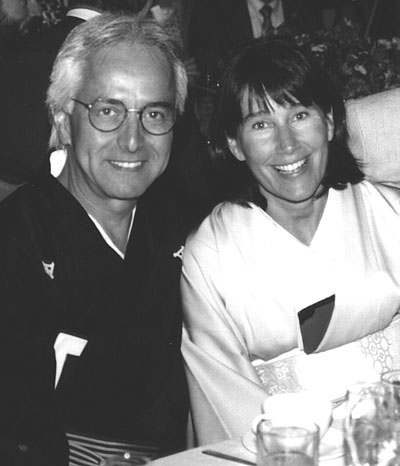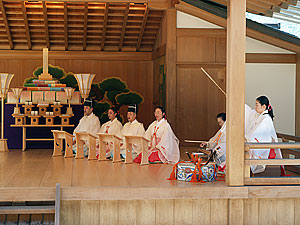
By Mario Uribe

Mario & Liz Uribe
–"Ah, so desuka?", was my father's teasing response at my attempt at humor while our family sat around the dinner table on a typical Sunday evening. I was eight years old then, but I was very familiar with his retort, which I had been hearing since I was old enough to sit at the dinner table and join the conversation.
Our house in Mexico, where I grew up, was a sturdy, multi-arched, Spanish style brick house covered with white stucco and crowned with red clay tiles being slowly overtaken by the much more brilliant red of a climbing Bouganvillia vine. It was all that it appeared to be on the outside; but on the inside, a Japanese aesthetic influenced a
decor and sense of mood, which deceived the outside. Japanese furniture, dolls, baskets, and wood block prints were set off by the tearoom-green of the walls. As a consequence of my father's import business, my parents lived in Japan in 1939, and 1940, and along with their memories, they brought back to Mexico their favorite reminders of the places and people that had made their stay in Japan so special: mementos from Kyoto, Nara, Kamakura, Osaka, Kobe, Yokohama, and other places, which to an eight year-old, sounded like far away exotic fantasies from a fairy tale story. There were photos of places and friends, bronze Buddhas, sake cups, tea bowls, baskets, carvings, and, my favorite, a big bronze sitting Hotai on a pedestal, his huge round belly rubbed shiny-smooth by everyone that came into contact with it; it always brought a smile to my face – one to match his own. But not only objects did they bring back; the most enduring legacy my parents brought back, their real gift to us, was their love of Japan, which they shared with all five of us children. Of the five however, only I was bewitched completely by Japanese refinement.
Even at that young age, I was already in love with Japan and would repeat back, to my father's delight, "Ah, so desuka?", without really knowing what it meant. Now, I am an artist by profession, (and by the way, I know now what it means), and Japanese traditional arts are at the heart of my creative expression. One of the first drawings I remember signing my name to as a child, was a landscape with Mt. Fuji in the background and a Japanese fisherman going home with his catch of the day dangling from a branch that rested on his shoulder. I had copied it from a woodblock print, and gave it to my grandmother as a gift – I was four years old. I opened my heart to Japan then, and in return, Japan has filled it with measureless gifts.
My life precipitated along three cultures, Mexico, where I lived, the United States, where I was born and went to school, and Japan, where I always dreamed of being. After a long traditional Western art education, and forging ahead as an artist, I finally, and happily, came into real and physical contact with traditional Japanese arts when I attended The American School of Japanese Arts' seminar in San Francisco, in 1990. A part that lay dorment inside of me, patiently waiting, was re-born and blossomed through the practice of tea ceremony, calligraphy, kyogen, and ceramics during the ten-day seminar – which had been modeled after the Oomoto seminar. That experience led me to the realization of my long held dream of traveling to Japan, and my encounter with Oomoto, to participate in their summer seminar. My friend Bodhi Fishman and I traveled there together
–"I feel like I'm coming home", I said to Bodhi, and we both looked wide-eyed out the rear windows of the taxi cab we had taken at Kameoka station as it drove through the gates of Oomoto; my heart overflowed with emotion
–"Yes, I know what you mean.", he replied.
Bodhi stayed in Japan that year, studying at Doshisha University. I returned the next year for the 1992 reunion seminar at Oomoto – besides the arts, we learned and practiced Shinto ritual that year. To call that experience profound would not do it justice, it was beyond mere words – Oomoto and the arts became an indispensable part of me – no less than breathing. The work and philosophy of Onisaburo Deguchi and Naohi Deguchi, became an inspiration to me, and has guided me ever since, as I continue to explore my own creativity from a more spiritual perspective as a result. Since 1990, I have seriously immersed myself in the study of Chanoyu and Shodo. The principles of these two arts have become an integral part of my path in life, and their influence is evident not only in my artwork, but in my everyday life in general.
I return to Japan, and Oomoto every year, and I continue to learn and be inspired each time. Now, I also bring friends with me with which to share my experience and love of Japan, its culture, and people. A further reward is that many of them also are transformed for the better by their visit to Oomoto and their practice of the arts.
New Contents Thu, May 20, 2010
- Oomoto participates in Sant’Egidio conference : Dialogue among religions and cultures : On divided island nation of Cyprus By Bill Roberts
- Photo Album : Portraits of three branches: Shoko, Tanegashima and Aomori By Bill Roberts
- Oomoto FAQ
- A Letter from Oomoto : Of mountains and myths By Bill Roberts
- Polyglot poem festival The Utamasturi is going international — what’s next? By Bill Roberts
- Ethics education program captures the spirit of Bankyo Dokon By Bill Roberts
- A Letter from Oomoto : A year’s worth of adventure in a summer of branch visits By Bill Roberts
- In Kumamoto, it’s all about water – and fire By Bill Roberts
- A speech by Nevada Taylor at the Kii Branch in Wakayama Prefecture on April 13, 2008.:An Encounter With Oomoto Through Aikido
- Utamatsuri, Poem Festival, in Tokyo(on April 17, 2008)
- A speech by Neil Ryan Walsh at the Kobe branch on Mar. 9th, 2008.:Planting the Seeds of the Soul
- Meeting with the Fifth Spiritual Leader of Oomoto, Madame Kurenai Deguchi by Neil Ryan Walsh
- A speech by Neil Ryan Walsh at the Nagoya branch on Feb. 17th, 2008.:The Japanese Arts beyond National Boundaries
- To the Oomoto branch in Nagoya: City of Eel and Toyota by Neil Ryan Walsh
- A Speech by Nissim Ben Shitrit, Ambassador of Israel on the occasion of the Oomoto Setsubun Grand Festival in Ayabe February 3rd, 2008 : Japan and Israel : Two Lands Balancing the Needs of Traditional Culture and Modern Life. r
- A permanent memorial to Onisaburo (A Speech at the Autumn Grand Festival , November 6, 2007 : )By James Parks Morton, Founder and Chair, Emeritus of The Interfaith Center of New York
- Israel, Palestine and the Power of Poetry(Oomoto believes small efforts can have lasting ripple effects on people and peace)By Bill Roberts
- “Something Great”(This genetics pioneer, a friend of Oomoto, offers a clue to the mystery of life)By Bill Roberts
- Kamishima Cleanup (Harima branch members regularly visit this sacred island to keep the shrine tidy)By Bill Roberts
- Kyotaro Deguchi was one of six recipients of the 2007 James Parks Morton Interfaith Award
What is Oomoto?
- What is Oomoto?
- Spirtual Centers
- Founders and Spiritual Leaders
- History
- Organization and activities
- Teachings and scriptures
- Art Works of Founders and Leaders
Opinions[Archive]
- Statement of regret for the outbreak of war against Iraq (March 20,2003)
- Jinrui Aizenkai dispatched the "Urgent Appeal for a World (Global) Crisis" on March 14.
Grappling with Bioethics[Archive]
- Oomoto’s support for abolishing the death penalty (12, June 2003)
- The Oomoto Foundation protests any birth of a human clone baby. (5, January 2003)
- OOMOTO'S VIEW REGARDING JAPAN’S PERMITION TO THE RESERCH OF HUMAN EMBRYONIC STEM CELLS (ES cells)(12, June 2000)
Vistor’s Review[Archive]
- A speech by Bill Roberts at the Oomoto branch in Hiroshima after its monthly service on March 18, 2007:Encounters with war and peace
- How Bankyo Dokon changed one life by Linda Macphee
- A speech by Bill Roberts at the Hokuriku (Kanazawa) branch on Dec. 3, 2006:Ritual and myth -an encounter with ‘divine madness’
- A speech by Bill Roberts at the Himeji Cultural Center on Feb. 25, 2007:Mesmerized by the Japanese Arts
- A speech by Bill Roberts at the Kobe branch on Feb. 11th, 2007.:There are just human tears and human joy
- A Speech on the occasion of the Oomoto Setsubun Grand Festival in Ayabe February 3rd, 2007 : Egypt's role in Middle East peace
- Keynote Speech for the 28th World Federation Japanese Religionists Conference for World Peace in Tokyo (at Kokugakuin University, Novermber 29, 2006):Vision for Peace in the Middle East By Dr. Munther S. Dajani, Professor Dean, Faculty of Arts, Al Quds University, Jerusalem
- A speech to the Kyoto branch:Spiritual adventures in researching Oomoto leaders
- A Speech at The Oomoto Foundation on Monday, November 6, 2006 : Jordan's role in Middle East By Samir Nouri, Ambassador of the Hashemite Kingdom of Jordan
- A letter from Oomoto:The Young People of Tottori
- A speech by Bill Roberts on the occasion of the dedication ceremony for the new shrine of Tottori Branch By Bill Roberts Oct. 8, 2006
- A speech by Bill Roberts at the Oomoto branch in Hiroshima after its monthly service on March 18, 2007:Encounters with war and peace
- How Bankyo Dokon changed one life by Linda Macphee
- A speech at Setsubun : A Portrait of Oomoto By Bill Roberts Feb. 3, 2006
- New Publication ! By Bill Roberts Feb. 3, 2006 A Portrait of Oomoto
you can read this book in html => http://www.jinruiaizenkai.jp/English/en-kolumno/en-bill/en-sugao/billbook1en.html
E-mail below to order brobert1@ix.netcom.com
Current Topics
- Prayer Offering and World Religious Forum II
- Living the art of dialogue
- Kyotaro Deguchi was one of six recipients of the 2007 James Parks Morton Interfaith Award
Books
Online Books
- Divine Signposts by Onisaburo DEGUCHI
- The Creation of Meaning by Hidemaru Deguchi
- Bankyo Dokon(Seventy years of Inter-Religious Activity at Oomoto)
- Nao Deguchi — A Biography of the Foundress of Oomoto
- The Great Onisaburo Deguchi published by Aiki News
- Bankyo Dokon Seventy Years of Inter-Religious Activity at Oomoto
- Insearch of Meaning
- Nao Deguchi A Biography of the Foundress of Oomoto
- A Portrait of Oomoto By Bill Roberts
Oomoto international Archive
- The History of Oomoto (Jan.– Mar. 1980 — Apr.– Jun. 1982)
- The Ancestors; Friends or Foes? (Apr.– Jun. 1987)
- Tsukinamisai; The Sabbath of Shinto (Jan.– Jun. 1983)
- The Poem Festival at Oomoto; An Ancient Rite Lives Again (Oct.– Dec. 1981)
- Purification of the Universe ; Oomoto's Setsubun Festival (Apr.– Jun. 1981)
Links
Flowers at Ten'on-kyo & Baisho-en (photographs)
Contact
All rights reserved : the Oomoto Foundation Produced by the Netinformational Commission
Since : Mar. 7.1998 Last Update : Thu, May 20, 2010
E-mail : webmaster@oomoto.or.jp
Top Page Nihongo Esperanto Português Roomazi



